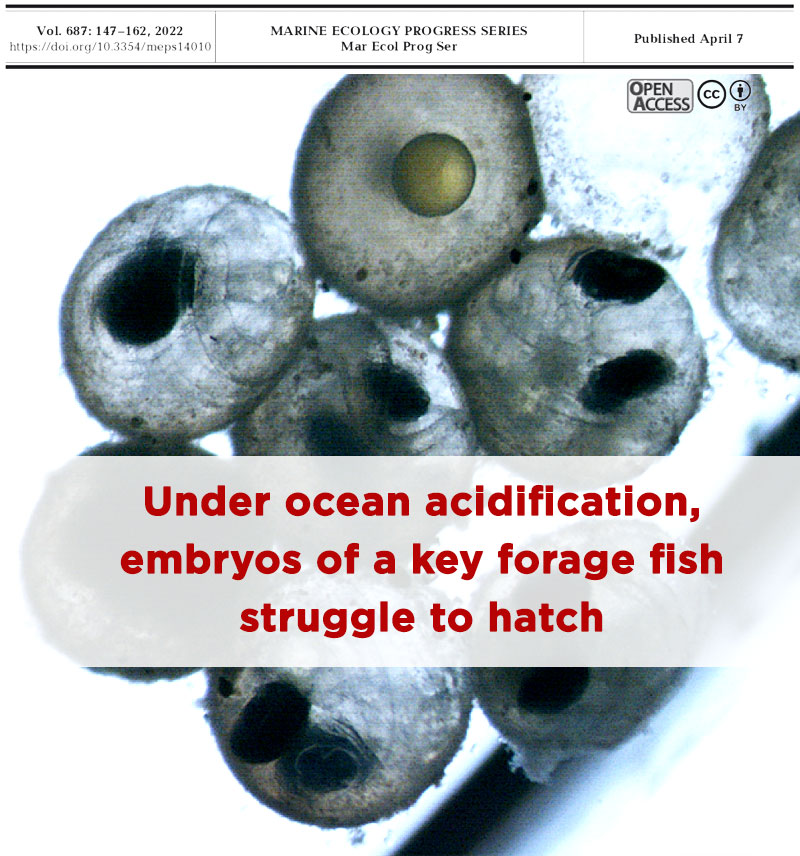Under Ocean Acidification, Embryos of a Key Forage Fish Struggle to Hatch
A potential ripple effect from carbon in the atmosphere could have severe impacts throughout the ocean ecosystem

By Elaina Hancock. Reposted from UConn Today, 7 April 2022
When carbon is emitted into the atmosphere, about a quarter of it is absorbed by the earth’s oceans. As the oceans serve as a massive ‘sink’ for carbon, there are changes to the water’s pH – a measure of how acidic or basic water is. As oceans absorb carbon, their water becomes more acidic, a process called ocean acidification (OA). For years, researchers have worked to understand what effect this could have on marine life.
While most research so far shows that fish are fairly resilient to OA, new research from UConn, the University of Washington, the National Oceanic and Atmospheric Administration (NOAA), and Southern Connecticut State University, shows that an important forage fish for the Northwest Atlantic called sand lance is very sensitive to OA, and that this could have considerable ecosystem impacts by 2100. The team’s findings have just been published in Marine Ecology Progress Series 687.
Sand lance spawn in the winter months in offshore environments that tend to have stable, low levels of CO2, explains UConn Department of Marine Sciences researcher and lead author Hannes Baumann.
“Marine organisms are not living in a uniform ocean,” Baumann says. “In near shore environments, large CO2 fluctuations between day and night and between seasons are the norm, and the fish and other organisms are adapted to this variability. When we stumbled upon sand lances we suspected they are different. We thought that a fish that lives in a more open-ocean offshore environment might be more sensitive than the near-shore fish because there’s just much less variability.”
The project was a collaboration with physical oceanographers, including Assistant Professor of Marine Sciences Samantha Siedlecki and Michael Alexander from NOAA’s Physical Sciences Laboratory in Boulder, Colorado, who modeled CO2 levels in 2050 and 2100 for a specific part of the Gulf of Maine where sand lance spawn. Then Baumann and his team reared sand lance embryos in the lab under experimentally higher CO2 levels matching the projected levels.
There are instances of direct fish mortality as result of elevated CO2, but they are rare, says Baumann. However, sand lance embryos proved to be exceptionally sensitive, and fewer embryos hatched under future oceanic CO2 conditions. The researchers repeated the experiments three more times to avoid jumping to conclusions but each time they observed the same result.
“We found that embryo survival-to-hatch decreased sharply with increasing CO2 levels in the water, concluding that this is one of the most CO2-sensitive fish species studied thus far,” Baumann says.
Sand lances are surely one of the most important forage fish here on the Northwest Atlantic shelf… The humpback whales, sharks, tuna, cod, shearwaters, terns — you name it — they are all relying on sand lance.
With this interdisciplinary approach combining model forecasts and serial experimentation the researchers arrived at a picture that is much more specific.
“We consequently applied principles of serial experimentation, which is a most timely and important topic in ocean acidification research right now,” Baumann says. “Because our findings are backed up by repeated independent evidence, they are more robust than many published ocean acidification studies to date.”
In addition to preventing many sand lance embryos from developing normally, the researchers document a second negative, and novel, response to elevated CO2. Higher CO2 levels appear to make it harder for embryos to hatch.
Baumann explains the lowered pH likely renders enzymes needed for successful hatching less effective, leaving the embryos unable to break through their eggshell (chorion) to hatch.
The results show that by 2100, due to acidification, sand lance hatching success could be reduced to 71% of today’s levels. Since sand lance are such a critical component of the food web of the Northwest Atlantic, this marked decrease in sand lance would have profound impacts throughout the ecosystem.
“Sand lances are surely one of the most important forage fish here on the Northwest Atlantic shelf,” Baumann says. “Their range spans from the Mid Atlantic Bight all the way to Greenland. Where we studied them, on Stellwagen Bank, they are called the backbone of the ecosystem. The humpback whales, sharks, tuna, cod, shearwaters, terns — you name it — they are all relying on sand lance, and if sand lance productivity goes down, we will see ripple effects to all these higher trophic animals. Even though we humans don’t fish for sand lance, we need to take care of the species because it has such a huge effect on everything else.”
Baumann says this study supports the hypothesis that offshore, high latitude marine organisms like the sand lance may be among the most vulnerable to OA. As a result, these organisms and food webs will likely be impacted first and soon, and we must act now.
Previous research has focused on opportunistically chosen species when testing their sensitivity for ocean acidification, says Baumann, but this should change.
“We need strategic thinking about what species we are testing next, because we cannot test every marine fish species, that’s an impossible task. We should concentrate on fish species that are likely the most vulnerable, and therefore the ones that are probably being affected first and this research makes a compelling argument that those are the fish species at higher latitudes and in more offshore than nearshore environments.”
- Baumann, H., Jones, L.F.*, Murray, C.S., Siedlecki, S.A., Alexander, M., and Cross, E.L. (2022)
Impaired hatching exacerbates the high CO2 sensitivity of embryonic sand lance, Ammodytes dubius
Marine Ecology Progress Series 687:147-162